The Lady Ivy Wu
book Collection
(1667-1787)
Selected from
the Anton Library for Chinese Studies
The Lady Ivy Wu book Collection
About the Collection
The Lady Ivy Wu Collection has been curated to narrate a compelling story—one that, like all captivating tales, commences with courage. It is the courage to engage, to wonder, and to celebrate the diversity among people from around the world. This collection highlights cross-cultural travelers and leaders who confronted numerous trials and tribulations while acquainting themselves with individuals from lands vastly different from their own. They made a deliberate choice to share their acquired knowledge with their own people, contributing to a body of understanding that very few had ventured into before. Over the course of hundreds of years, these storytellers accentuate unique perspectives, immersing themselves in diverse cultures and communities with each deliberate step. We hope that everyone who reads this booklet finds inspiration in the courage displayed by these authors, encouraging them to embark on a similar journey of exploration and understanding.
Catalogue
-
China Monumentis qua Sacris qua Profanis, nec non variis naturae et artis spectaculis, aliarumqu rerum memorabilium argumentis illustrate. 01
-
LES MISSIONARIES DE PEKIN: MEMOIRES CONCERNANT L’HISTOIRE, LES SCIENCES, LES ARTS, LES MOEURS, LES USAGES &C. DES CHINOIS. TOME II. 02
-
Confucius sinarum philosophus, sive scientia sinensis latine exposita. Prospero Intorcetta, Christian Wolfgang Herdrich; Francois de Rougemont, and Philippe Couplet. 03
-
Description Generale de la China, Contenant. Vol. 1: La Description topographique des quinze Provinces qui forment cet Empire, cella de la Tartarie, des Isles, & autres pays tributaries qui en dependent; le nombre et la situation de ses Villes, l’etat de sa population, les productiones, varies de sons Sol, & les principaux details de son Histoire Naturelle. Nouvelle edition, avec Cartes et Figures. 04
-
Description Generale de la China, Contenant. Vol 2: Un Precis des connoissances le plus recement parvenues en Europe sur le Government, la Religion, les mouers & les Usages, les Arts & les Sciences des Chinois. Nouvelle edition, avec Cartes et Figures. 05
-
Nouvelle Relation de la Chine, contenant la description des particularitez les plus considerable de ce grand empire. 06
The Lady Ivy Wu Collection
Collection introduction
01
China Monumentis qua Sacris qua Profanis, nec non variis naturae et artis spectaculis, aliarumqu rerum memorabilium argumentis illustrate.
Athanasius Kircher
Amstelodami: Joannem Janssonium a Waesberge & Eliezeum Weyerstraet, 1667.
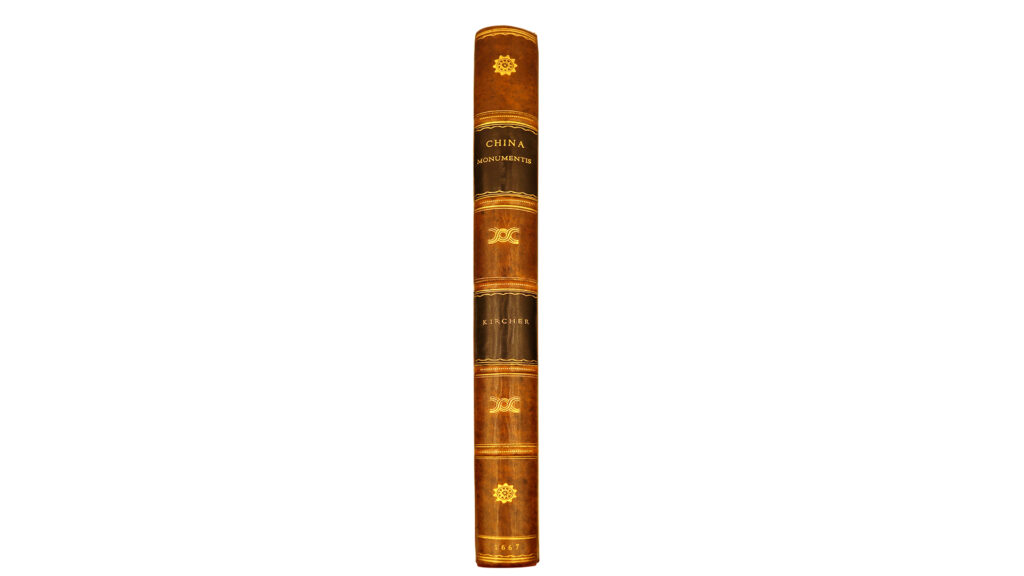
This book meticulously traces the historical intersections between Europe, missionaries, and China, providing valuable insights into the diverse Oriental peoples, encompassing aspects such as Chinese literature, customs, and cultures. Compiled from missionary accounts, it aspires to consolidate their amassed knowledge, further enriched by the author’s original research—particularly emphasizing the Chinese language. This work represents a distinctive and invaluable addition to European understanding of China.
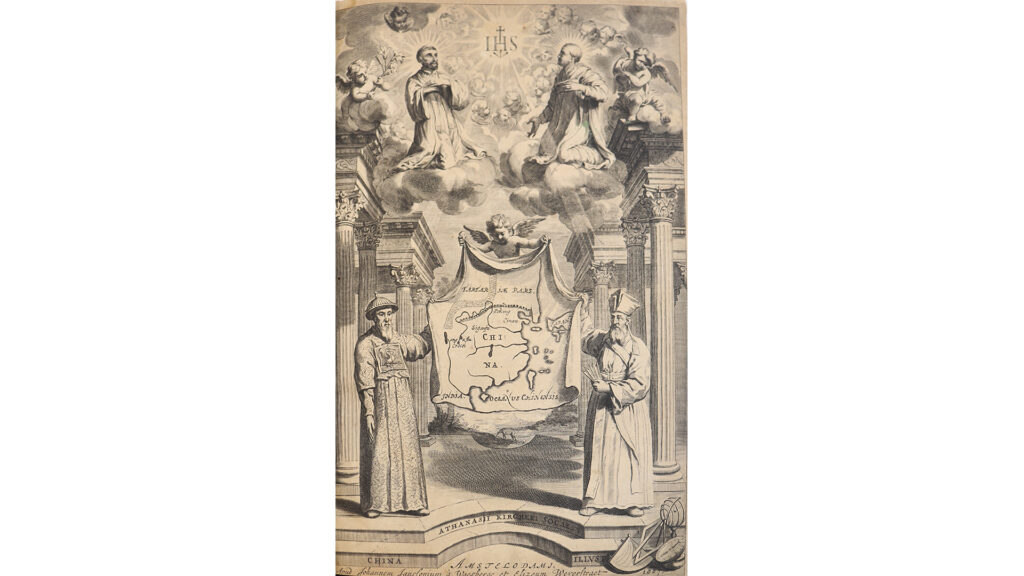
With its vivid depiction of ancient China, this work has made a notable global impact, presenting European audiences with a fresh perspective. In its inaugural year, it garnered over 7,000 publications and has since been translated into more than 6 languages. However, criticism has surfaced from scholars who view the book more as entertainment than education. They argue that Kircher designed it for a general audience rather than scholarly pursuits, contending that it lacks the depth necessary for serious study and research on China.
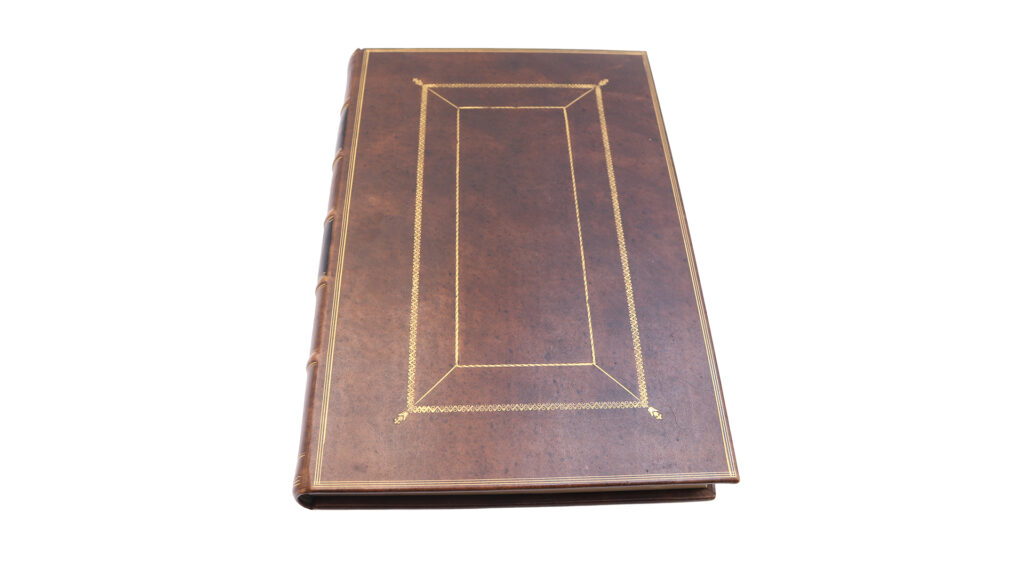
China Monumentis was authored by Athanasius Kircher, a German Jesuit scholar and polymath hailed as the “Master of Hundred Arts.” Intrigued by Sinology, he penned this comprehensive encyclopedia on China, revealing the early presence of Nestorian Christians. In addition, Kircher endeavored to establish connections between China, Egypt, and Christianity. Despite his passionate pursuits in Egyptology and geology, later historians found some of his findings, particularly in these realms, to be inaccurate. Nonetheless, his overall commitment to learning remains a noteworthy aspect of his legacy.
02
LES MISSIONARIES DE PEKIN: MEMOIRES CONCERNANT L’HISTOIRE, LES SCIENCES, LES ARTS, LES MOEURS, LES USAGES &C. DES CHINOIS. TOME II.
Joseph-Marie Amiot, Pierre Martial Cibot, and Aloys Kao. Paris, Nyon, 1777.
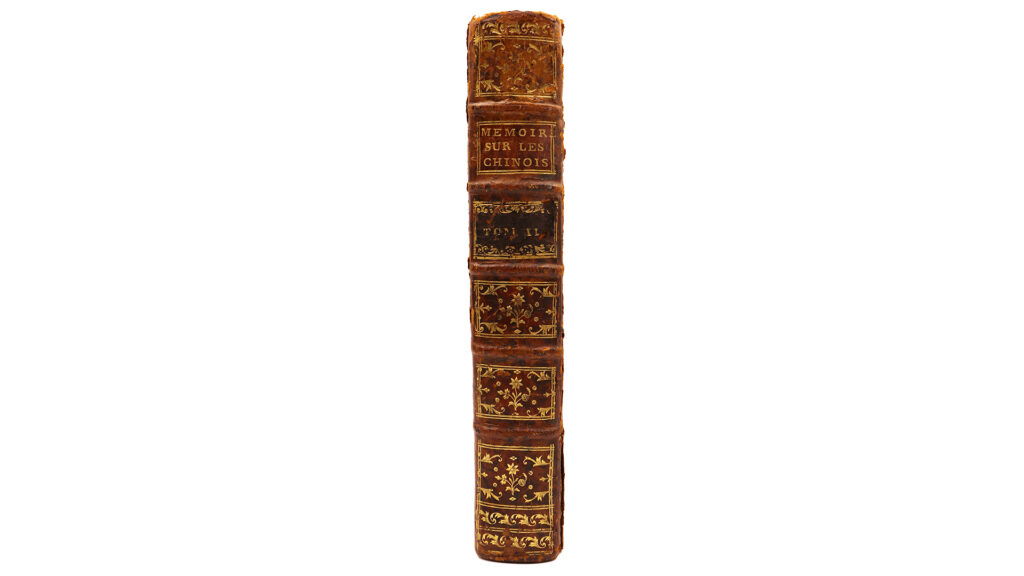
Louis XV of France, seeking to reform his nation’s spirit, took the suggestion of his Minister of State, Henri Bertin, to “inoculate the French with the Chinese spirit.” This proposal laid the foundation for this book.
This rare 18th-century survey of Chinese life encompasses translations of Confucian Classics, Chinese law, proverbs, and essays on linguistics and scientific observation. Engraved illustrations, inspired by contemporary Chinese depictions, vividly depict various themes, including philosophical and historical figures, military affairs, and music, seamlessly blending both Chinese and Western artistic styles. Notably, the ninth volume showcases 12 exquisite Pictures of Yanzhou Flood Reconstruction, faithfully replicating the prototypes of Chinese paintings.
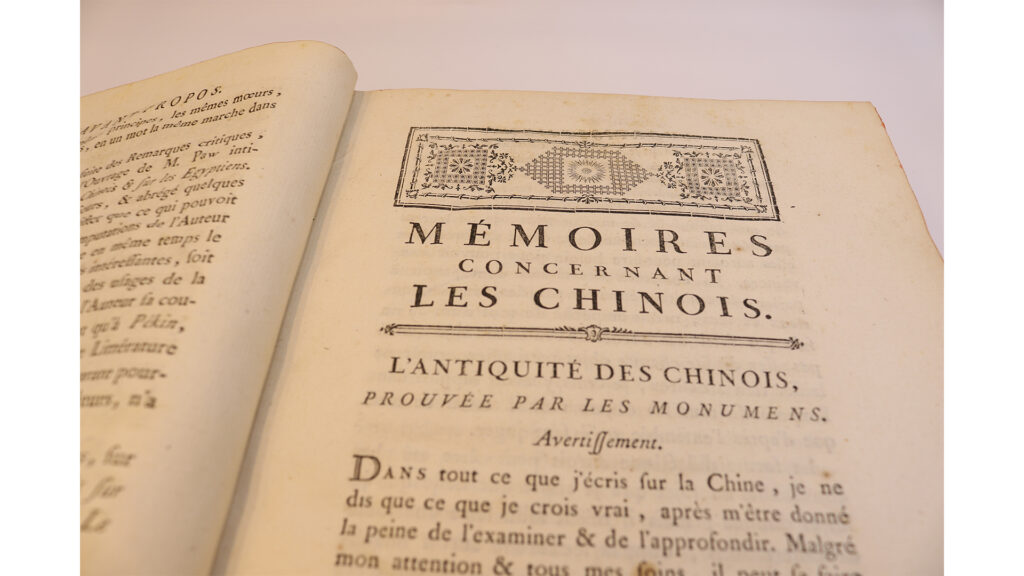
TBC preserves the original Volume 2 within the initial set of 17 volumes, featuring three memoirs about China and a brief poem centered around Chinese bamboo. Moreover, TBC possesses later prints of Volumes 1-9, spanning the years 1786-1814, seamlessly integrated into the Lady Ivy Wu Collection. Presently, the book exists in 15 versions and is curated in 156 libraries globally. Noteworthy institutions such as the Edinburgh University Library in England, Macau University of Science & Technology in China, and the University of Hawaii at Manoa in America, alongside TBC, house this remarkable book.
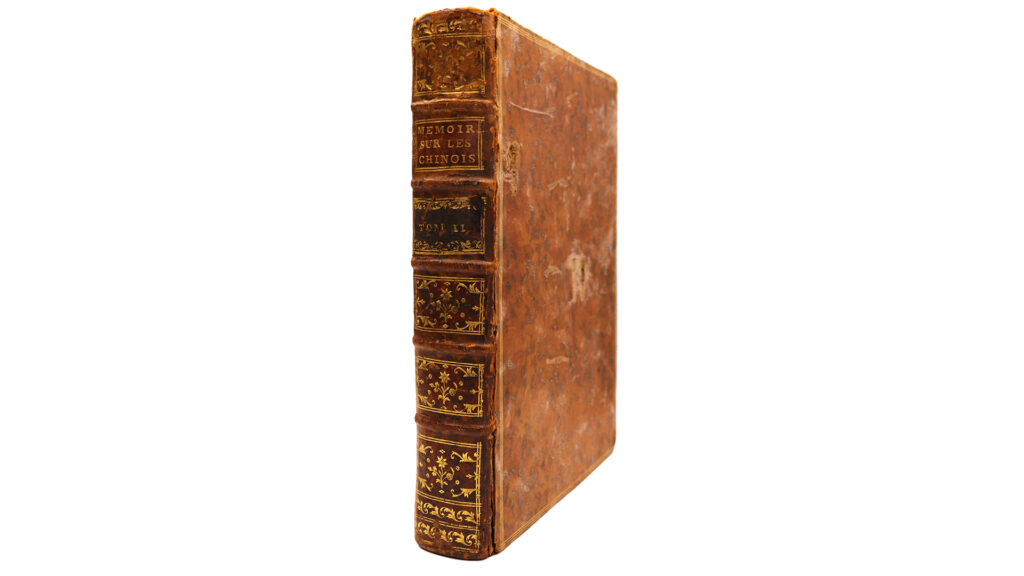
Joseph Amiot, along with Gaubil, Prémare, Cibot, and Poirot, collectively authored the book, with Amiot as the primary contributor. His journey commenced with a fervent desire, expressed in an early letter to his superiors in Rome, to serve in a delegation to China. Arriving in Macau on July 27, 1750, he reached Beijing on August 22 of the same year. In Beijing, he assumed responsibility for the children’s congregation of the Holy Guardian Angels, residing there for 43 years. Concurrent with his preaching duties, he dedicated the majority of his energy to the study of Chinese culture.
Joseph Amiot immersed himself in the study of the Chinese language, adopting the name Qian Deming and embracing traditional attire. He introduced various facets of Chinese knowledge, encompassing history, language, Confucianism, music, and medicine, to France. His endeavors garnered widespread attention from cultural circles in France and throughout Europe, establishing him as a crucial intermediary between European academics and China.
03
Confucius sinarum philosophus, sive scientia sinensis latine exposita. Prospero Intorcetta, Christian Wolfgang Herdrich; Francois de Rougemont, and Philippe Couplet.
Paris: Danielem Horthernels, 1687.
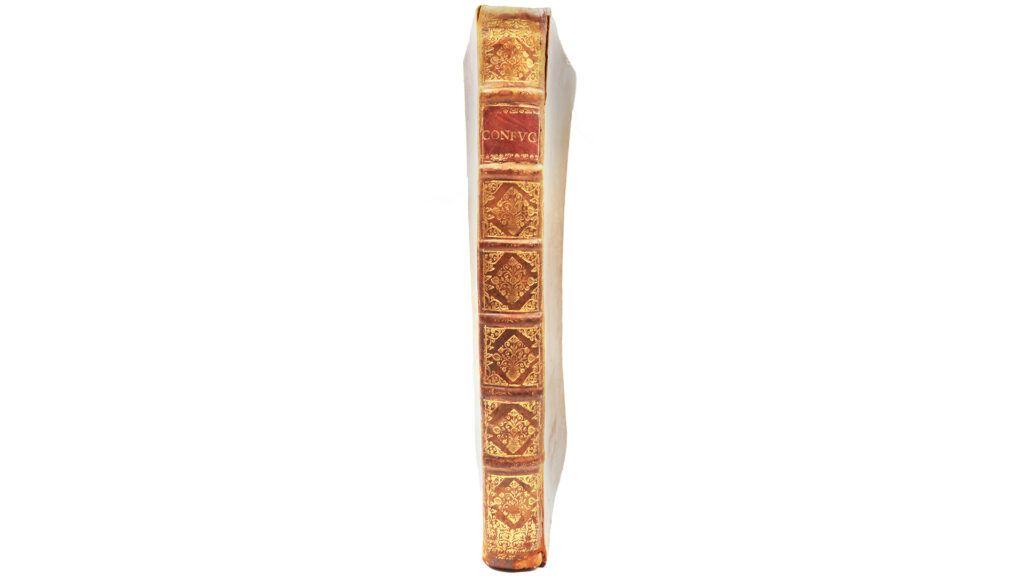
Confucius sinarum philosophus, sive scientia sinensis latine exposita, published in 1687, is the first edition print of the three major Confucian classics to be published together in any language other than Chinese. It is published in Latin, making it the first recorded example of Confucian texts published in any European language. The Latin title translates to “Confucius the philosopher of China, or, the knowledge of China translated into Latin.”
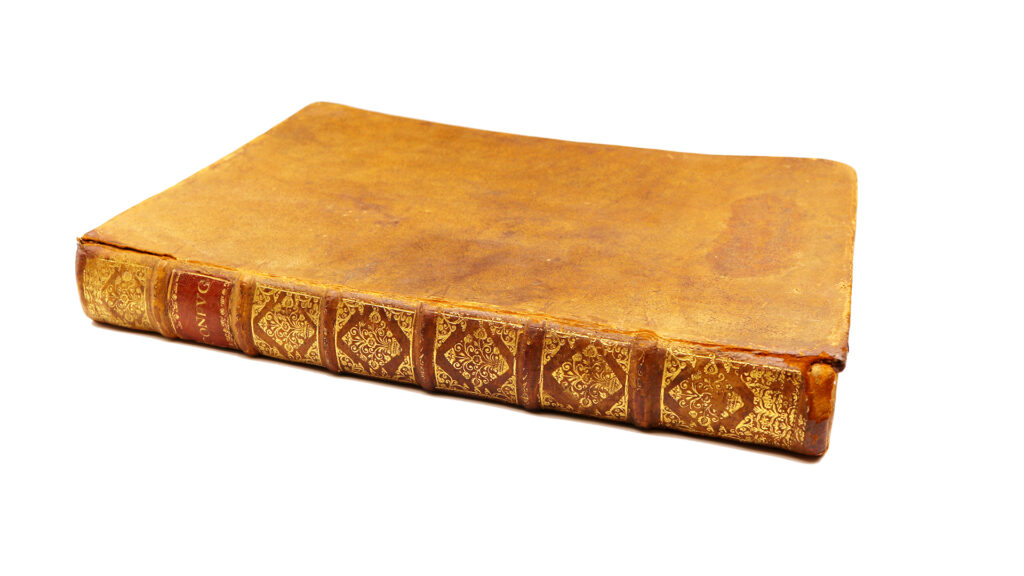
The book comprises Latin translations of three Confucian classics: Da xue (the Great Learning), Zhong yong (the Doctrine of the Mean), and Lun yu (the Analects). They are three of the Four Books, with the book by Meng Zi (Mencius) not included. The Four Books are Chinese classic texts illustrating the core value and belief systems in Confucianism. They were selected by Zhu Xi in the Song dynasty (960-1279) to serve as a general introduction to Confucian thought, and they were made the core of the official curriculum for the civil service examinations in the Ming and Qing dynasties.
The book is the product of the labors of four Jesuit priests who were missionaries in China: Philippe Couplet (1623-1693), Christian Herdtrich (1625-1684), Prospero Intorcetta (1625-1696) and Francis Rougemont (1624-1676). However, this book was more than just the intellectual collaboration of these four men but the culmination of translation work by Michele Ruggieri (1543-1607). Ruggieri, Ricci’s predecessor, was not only the first European translator of the Four Books of Confucianism, but also a founding father of the Jesuit China missions and co-author of the first European–Chinese dictionary. He has been described as the first European sinologist.
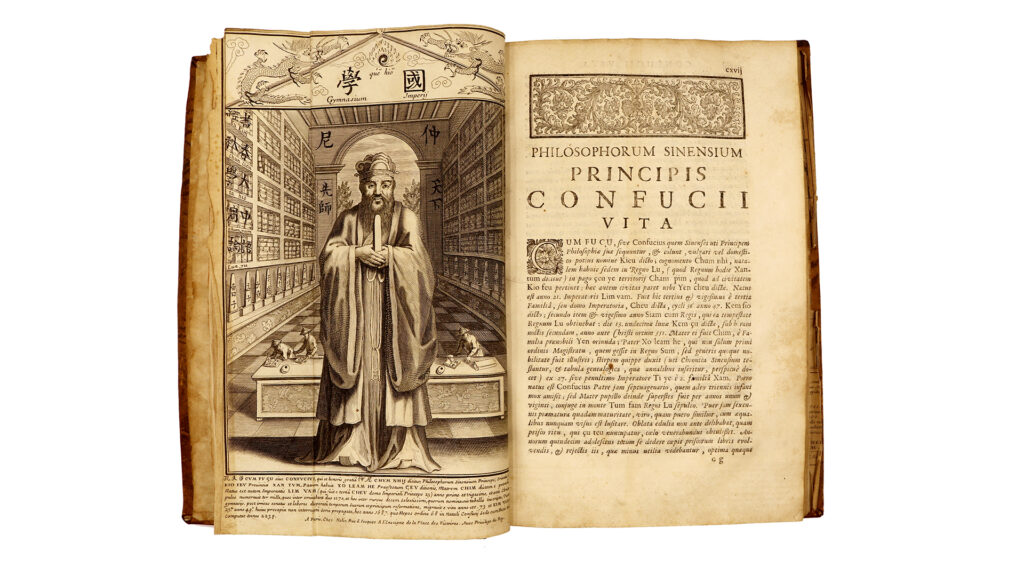
It was printed with royal privilege and dedicated to Louis the XIV, destined for the library of the Sun King, as a gift to his fine republic of letters. The dedication to Louis XIV was a planned action by the Jesuits in China, one in a long line of strategic planning (and indeed everywhere). They learned that they needed the help of influential people not only to fund their global efforts, but also to provide security during times of political turmoil. Dedicating this important intellectual work to Louis XIV was just one way of persuading the French king of the value of their endeavors and their desire for his continued support. It was also a risky gambit that paid off because Couplet, one of the editors, was also in charge of transporting the text to Europe, allowing him to present the work to the king himself.
04/05
Description Generale de la China, Contenant. Vol. 1: La Description topographique des quinze Provinces qui forment cet Empire, cella de la Tartarie, des Isles, & autres pays tributaries qui en dependent; le nombre et la situation de ses Villes, l’etat de sa population, les productiones, varies de sons Sol, & les principaux details de son Histoire Naturelle. Nouvelle edition, avec Cartes et Figures.
Jean-Baptiste Grosier. Paris: Chez Moutard, 1787.
Description Generale de la China, Contenant. Vol 2: Un Precis des connoissances le plus recement parvenues en Europe sur le Government, la Religion, les mouers & les Usages, les Arts & les Sciences des Chinois. Nouvelle edition, avec Cartes et Figures.
Jean-Baptiste Grosier. Paris: Chez Moutard, 1787.
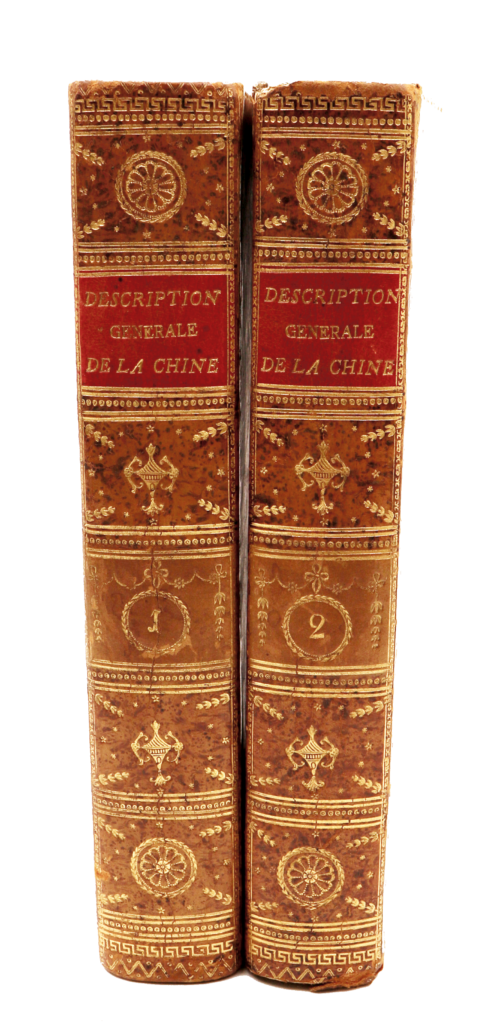
Description Générale de la Chine, a significant sinological masterpiece published in France in 1787 by Jean-Baptiste Grosier, meticulously compiles first-hand materials, primarily memoirs, letters, and articles sent and published by Jesuit missionaries in Europe. Its purpose is to introduce China’s national traditions and culture.
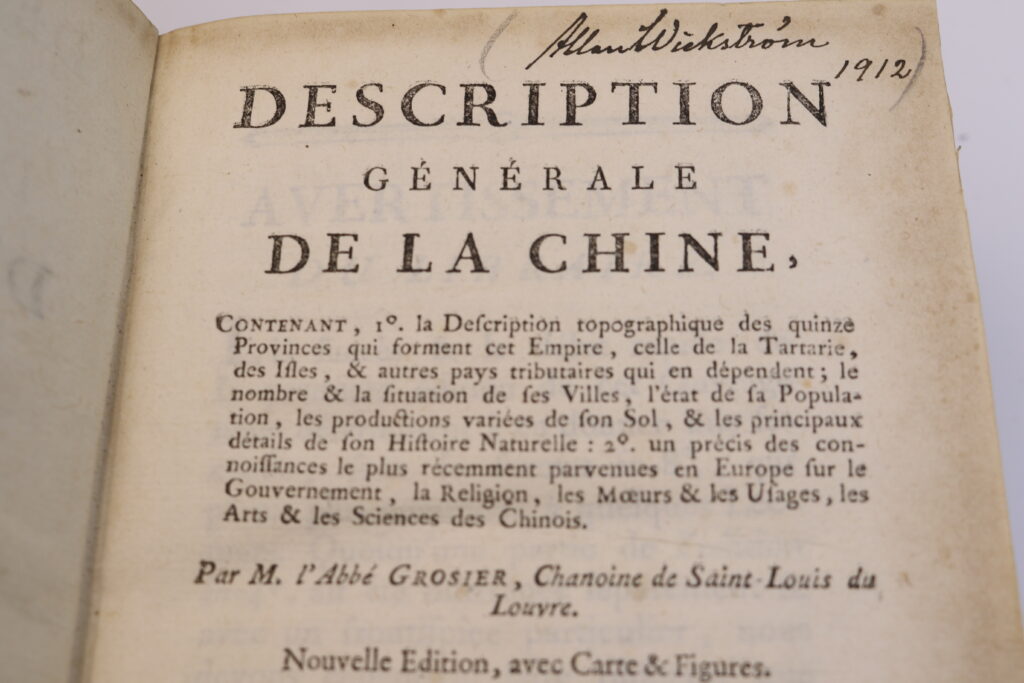
Originally conceived as a supplementary 13th volume to l’Histoire générale de la Chine in France in 1785, edited by French Jesuit Joseph-Francois-Marie-Anne de Moyriac de Mailla (1669–1748), as mentioned in Henri Cordier’s Bibliotheca Sinica (1849–1925). After its initial publication, the book was reprinted in 1787 and 1818–1820, with translations into English, German, and Italian. Experiencing widespread popularity, it emerged as the best-selling Sinology work in Europe and a state-of-the-art Sinology study in France during that era.
This comprehensive work employs an encyclopedic narrative style with a grand layout, offering a detailed exploration of China’s geography, nature, history, society, economy, politics, military, belief, language, literature, and science.
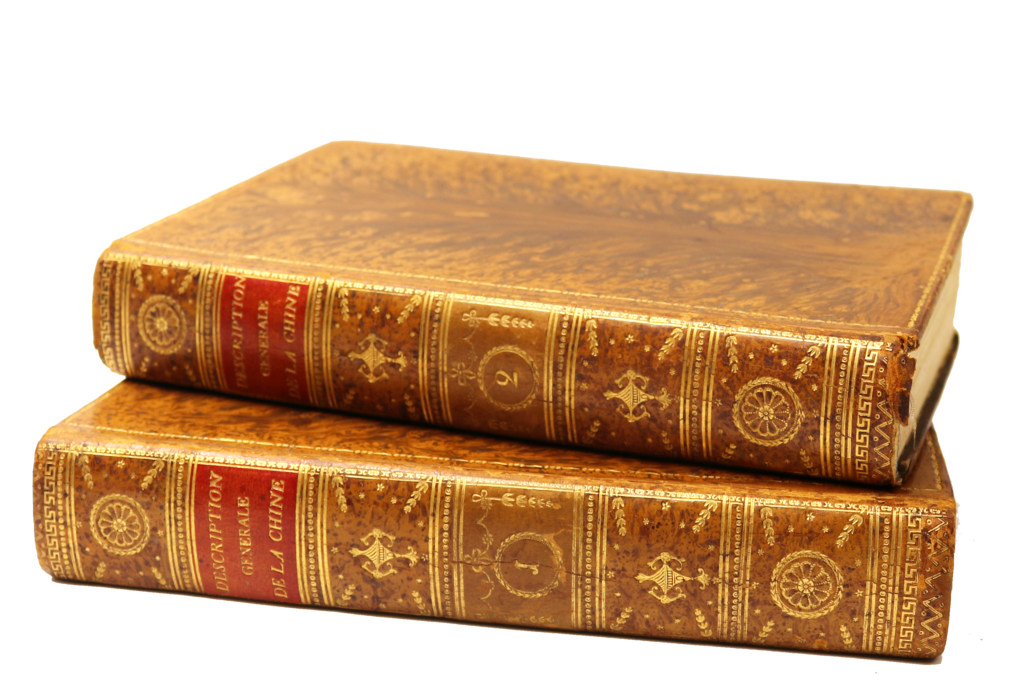
TBC has preserved this work in its Anton library, encompassing both Part I and Part II. Part I offers a comprehensive overview of the 15 provinces in the former Chinese Empire, encompassing Tartary, specific islands, and dependencies. It delves into detailed descriptions of cities, population statistics, material resources, soil variations, and essential aspects of natural history. Meanwhile, Part II documents the latest (at the time) European insights into Chinese government, religion, customs, art, and science. The updated edition includes comprehensive maps and illustrations to enhance the understanding of the content.
Jean-Baptiste Gabriel Alexandre Grosier (1743–1823) was a distinguished scholar of the Society of Jesus. Not only did he author Description Générale de la Chine, but he also edited and published Histoire Générale de la Chine and Mémoires concernant l’histoire, les sciences, les arts, les moeurs, les usages, etc., des Chinois, par les missionnaires de Pékin, considered one of the three greatest Sinologist books in 18th-century Europe. Despite never embarking on a journey to China, Grosier meticulously compiled knowledge from Jesuit travelers. He served as a canon of St. Louis de Louvre and as the administrator of the Bibliothèque of the Arsenal in Paris, a branch of the Bibliothèque Nationale de France.
06
Nouvelle Relation de la Chine, contenant la description des particularitez les plus considerable de ce grand empire.
Gabriel de Magalhaes. Paris: Claude Barbin, 1688.
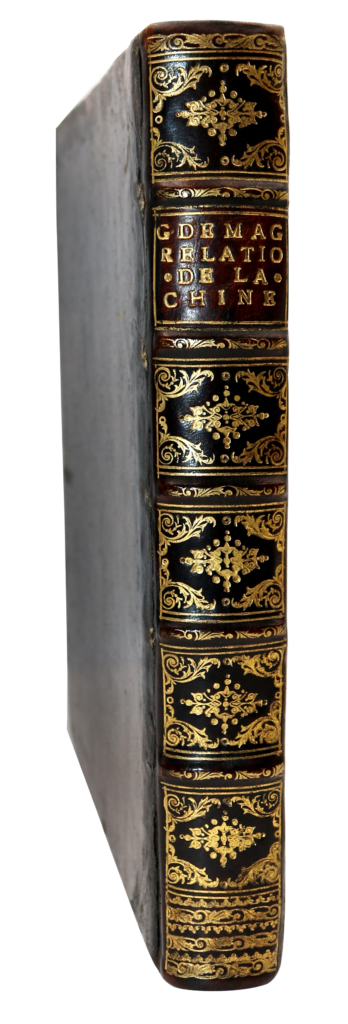
Nouvelle Relation de la Chine has been acclaimed by Donald Lach, a prominent authority in Asian 16th-18th century history, as “the most comprehensive and insightful account of China.” This book transcends the European perspective on the Chinese language, delving into China’s language, Chinese characters, and aesthetics. It offers detailed insights into China’s ancient philosophical thought, its extensive history, and the Chinese chronicle—a distinctive style of compiling history known for its remarkable precision and elegant organization.
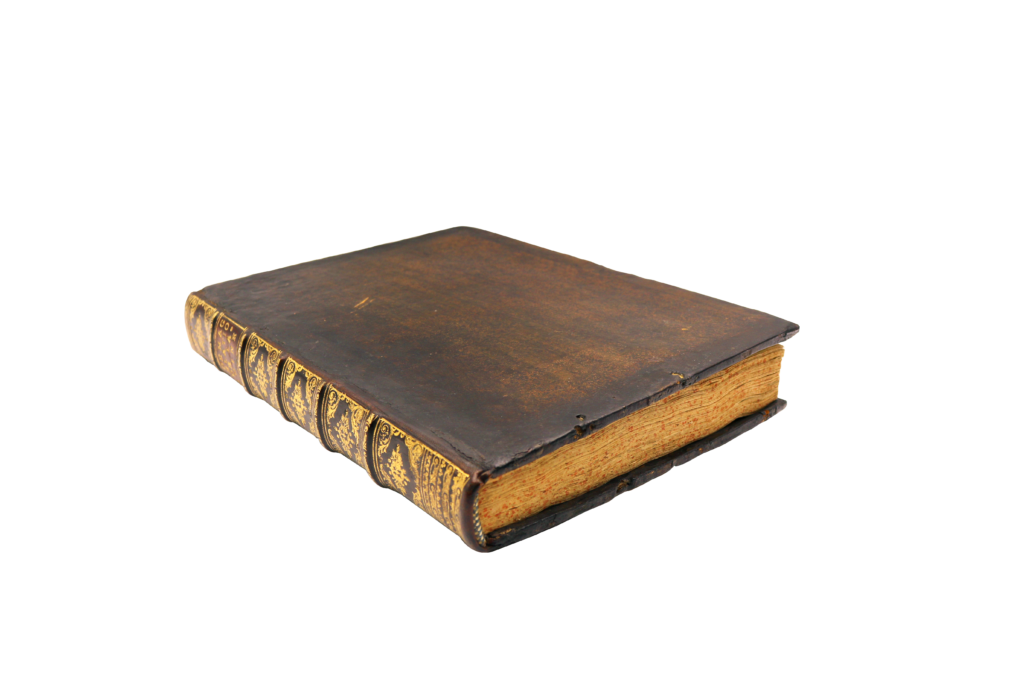
The book also highlights China’s accomplishments in various fields, with a particular emphasis on its remarkable architecture. It meticulously chronicles public construction projects in China, offering vivid descriptions of magnificent bridges, the Grand Canal, city walls, houses, major temples, and the imperial palace. This thorough account enables European readers to gain a nuanced appreciation for the shapes and layouts of Chinese buildings.
Furthermore, the book delves into other distinctive topics such as unique wax statues, sources of wealth in China, the state of the emperor’s treasury, grand ceremonies, and more. Through its comprehensive and detailed exploration of China, this book stands out as a valuable resource for attaining a deeper understanding of various facets of Chinese culture and history.

This book was authored by Gabriel de Magalhães (1619-1977), a Portuguese Jesuit renowned for his expertise in mechanics and adventurous spirit. Notably, the author hailed from the family of the famed navigator Ferdinand Magellan. Upon his arrival in Hangzhou in 1640, he extensively traveled throughout China until relocating to Beijing in 1648. In Beijing, he assumed the role of a repairer and technician of Western clocks and watches in the Forbidden City. Simultaneously, he actively broadened his understanding of China, evident in his descriptions of languages, interactions with influential figures, access to the court, chosen subjects, and detailed reports. Despite his contributions, he faced anti-Christian resistance, leading to his imprisonment in Beijing, where he ultimately passed away.
Translator (French version):
Abbé Claude Bernou later translated the book from Portuguese to French, enhancing readability by incorporating italicized notes at the end of each chapter. Additionally, he devised a plan of Beijing based on the text, further improving the book’s accessibility. TBC preserves the original French version of this book and the accompanying map.
